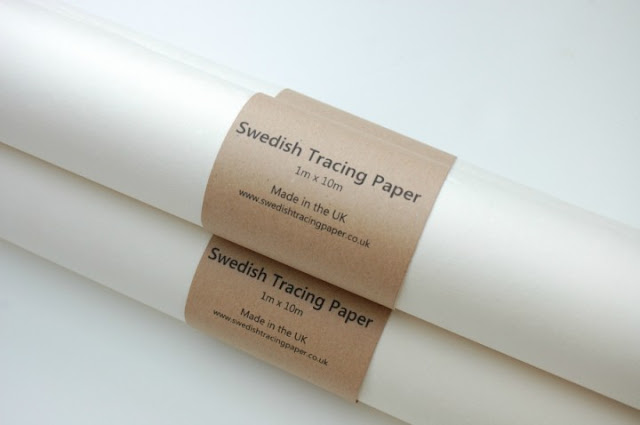Let's talk about Swedish Tracing Paper! I've heard lots about it but never actually worked with it, so when I was asked if I'd like to review it recently, I was keen as mustard! I know lots of sewists trace patterns as standard to preserve the original, but I'm not one of them. If I'm really not sure of the fit then yes, I'll trace it, but if I can avoid doing so, I will. Which is why I've only just got round to trying it out (it was sent to me in September…)
The company who produce it in the UK - The Swedish Tracing Paper Shop - describe it as 'a soft and translucent paper, resistant to tear but easy to see through, making it ideal for copying the detail from existing patterns.'It's also described as being suitable for making toiles as it's relatively strong and can be sewn. I needed to blend a pattern between sizes and make a toile, so thought I'd put it to the test for both uses.
The appearance of Swedish Tracing Paper is a bit like interfacing, but because it's a paper rather than a fabric its texture is stiffer. It's very easy to draw on and mark with pencil and I could see through it perfectly to trace my pattern.
Even though it comes on a roll, it still lies nice and flat. The pattern I was tracing was a relatively simple design, so I didn't even bother with pattern weights. You might need to weigh it down though if you were tracing a pattern with lots of markings or darts on it.
Later that day I traced a second version of the bodice piece and made a couple of adjustments at the neck and bust. There was a fair bit of sellotape involved and the Swedish Tracing Paper didn't tear once. Impressive!
When I came to sew the pattern pieces together to make my toile, I found its paperiness was a disadvantage. It doesn't have the drape of a fabric (or even an interfacing) so crumpled like mad during its stint at the sewing machine. Here's what it looked like after I'd sewn the front and back together.
The appearance of Swedish Tracing Paper is a bit like interfacing, but because it's a paper rather than a fabric its texture is stiffer. It's very easy to draw on and mark with pencil and I could see through it perfectly to trace my pattern.
Even though it comes on a roll, it still lies nice and flat. The pattern I was tracing was a relatively simple design, so I didn't even bother with pattern weights. You might need to weigh it down though if you were tracing a pattern with lots of markings or darts on it.
Later that day I traced a second version of the bodice piece and made a couple of adjustments at the neck and bust. There was a fair bit of sellotape involved and the Swedish Tracing Paper didn't tear once. Impressive!
When I came to sew the pattern pieces together to make my toile, I found its paperiness was a disadvantage. It doesn't have the drape of a fabric (or even an interfacing) so crumpled like mad during its stint at the sewing machine. Here's what it looked like after I'd sewn the front and back together.
It presses well though, I used a low setting on my iron and the creases came out immediately.
The material is strong enough to take stitches, but because it's paper there's absolutely no give. I noticed this particularly when I tried the toile on. The pattern I used wasn't an especially fitted design, but I found it impossible to get it over my head without ripping it. The lack of drape wasn't helpful in determining the fit either. I don't think it's similar enough to fabric to give a true idea of how a finished garment would look.
My conclusion is that for tracing pattern pieces Swedish Tracing Paper is excellent. It has good transparency, lies flat, is easy to draw on and easy to apply tape to - I'm a convert! As a material for making a toile with, not so impressive - I probably won't use it for that purpose again. I'm glad I put it to the test though!
If you fancy trying Swedish Tracing Paper out for yourself, you can claim 10% off by using the code JANE here. Happy Sunday! x
A roll of Swedish Tracing Paper was given to me free of charge for review. All views my own.
The material is strong enough to take stitches, but because it's paper there's absolutely no give. I noticed this particularly when I tried the toile on. The pattern I used wasn't an especially fitted design, but I found it impossible to get it over my head without ripping it. The lack of drape wasn't helpful in determining the fit either. I don't think it's similar enough to fabric to give a true idea of how a finished garment would look.
| My toile - after it was tried on |
If you fancy trying Swedish Tracing Paper out for yourself, you can claim 10% off by using the code JANE here. Happy Sunday! x
A roll of Swedish Tracing Paper was given to me free of charge for review. All views my own.






















